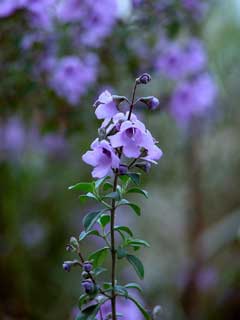 |
|
www.flickr.com/photos/edgeplot |
 |
|
Translate this page:
Summary
Physical Characteristics

 Prostanthera rotundifolia is an evergreen Shrub growing to 4.5 m (14ft) by 3 m (9ft).
Prostanthera rotundifolia is an evergreen Shrub growing to 4.5 m (14ft) by 3 m (9ft).
See above for USDA hardiness. It is hardy to UK zone 9 and is frost tender. It is in flower in May. The species is hermaphrodite (has both male and female organs) and is pollinated by Insects.
Suitable for: light (sandy), medium (loamy) and heavy (clay) soils and prefers well-drained soil. Suitable pH: mildly acid and neutral soils. It cannot grow in the shade. It prefers moist soil.
UK Hardiness Map
US Hardiness Map
Synonyms
Plant Habitats
Woodland Garden Sunny Edge;
Edible Uses
References More on Edible Uses
Medicinal Uses
Plants For A Future can not take any responsibility for any adverse effects from the use of plants. Always seek advice from a professional before using a plant medicinally.
Antibacterial Antifungal Carminative
The plant is rich in volatile oils, including menthol and cineole (as found in the mints, Mentha spp.)[238]. The leaves are antibacterial, antifungal and carminative[152, 154, 238]. They are used externally in the treatment of colds and headaches[238]. Presumably the leaves are infused in a bowl of hot water and the vapour inhaled[K].
References More on Medicinal Uses
The Bookshop: Edible Plant Books
Our Latest books on Perennial Plants For Food Forests and Permaculture Gardens in paperback or digital formats.

Edible Tropical Plants
Food Forest Plants for Hotter Conditions: 250+ Plants For Tropical Food Forests & Permaculture Gardens.
More

Edible Temperate Plants
Plants for Your Food Forest: 500 Plants for Temperate Food Forests & Permaculture Gardens.
More

More Books
PFAF have eight books available in paperback and digital formats. Browse the shop for more information.
Shop Now
Other Uses
Essential Pot-pourri
An essential oil obtained from the leaves is medicinal[154]. The leaves yield up to 0.7% of the oil[154]. The dried leaves are used in pot-pourri[238].
Special Uses
Scented Plants
References More on Other Uses
Cultivation details
Requires a sunny position in a well drained soil and does not thrive on shallow chalky soils[11, 200]. Prefers a humus-rich lime-free soil[182]. This species only succeeds outdoors in the mildest areas of the country[182]. It is hardy to at least -7°c in Australian gardens[157] though this cannot be translated directly to British gardens due to our cooler summers and longer colder and wetter winters. It does succeed outdoors in various places in Cornwall[1, 59], though it is probably best on a wall even there[11]. A short-lived plant, but it can be grafted onto the roots of Westringia fruticosa which allows it to be grown in less favourable conditions and also probably increases its life span[11, 157]. Plants are very tolerant of light trimming[K], but dislike hard pruning[238]. Any trimming is best carried out immediately after flowering[238]. Both leaves and flowers have a minty aroma[245].
References Carbon Farming Information and Carbon Sequestration Information
Temperature Converter
Type a value in the Celsius field to convert the value to Fahrenheit:
Fahrenheit:
The PFAF Bookshop
Plants For A Future have a number of books available in paperback and digital form. Book titles include Edible Plants, Edible Perennials, Edible Trees,Edible Shrubs, Woodland Gardening, and Temperate Food Forest Plants. Our new book is Food Forest Plants For Hotter Conditions (Tropical and Sub-Tropical).
Shop Now
Plant Propagation
Seed - sow spring in a greenhouse[200].The seed usually germinates within a few weeks. When they are large enough to handle, prick the seedlings out into individual pots and grow them on in the greenhouse for at least their first winter. Plant them out into their permanent positions in late spring or early summer, after the last expected frosts. The seed remains viable for 2 - 3 years in normal storage[154]. Cuttings of soft-wood in early summer in a frame. They root readily[11]. Cuttings of half-ripe wood, July/August in a frame[200].
Other Names
If available other names are mentioned here
Native Range
AUSTRALASIA: Australia (Tasmania, New South Wales, Queensland, Victoria)
Weed Potential
Right plant wrong place. We are currently updating this section.
Please note that a plant may be invasive in one area but may not in your area so it's worth checking.
Conservation Status
IUCN Red List of Threatened Plants Status :

Growth: S = slow M = medium F = fast. Soil: L = light (sandy) M = medium H = heavy (clay). pH: A = acid N = neutral B = basic (alkaline). Shade: F = full shade S = semi-shade N = no shade. Moisture: D = dry M = Moist We = wet Wa = water.
Now available:
Food Forest Plants for Mediterranean Conditions
350+ Perennial Plants For Mediterranean and Drier Food Forests and Permaculture Gardens.
[Paperback and eBook]
This is the third in Plants For A Future's series of plant guides for food forests tailored to
specific climate zones. Following volumes on temperate and tropical ecosystems, this book focuses
on species suited to Mediterranean conditions—regions with hot, dry summers and cool, wet winters,
often facing the added challenge of climate change.
Read More
Expert comment
Author
R.Br.
Botanical References
11154200
Links / References
For a list of references used on this page please go here
Readers comment